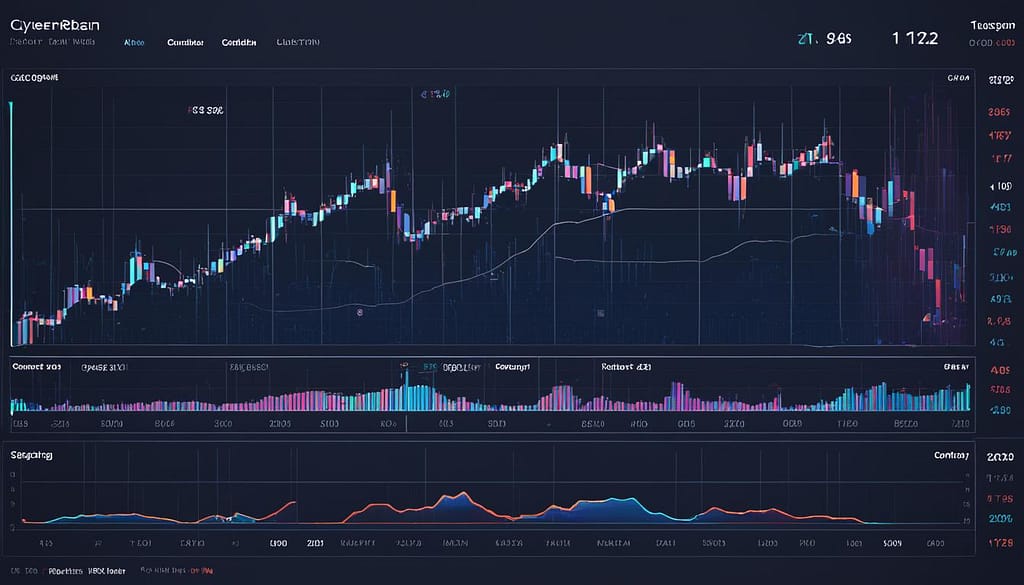Predicting Cryptocurrency’s Path
The Future of Cryptocurrency stands at a critical juncture, as advancements in blockchain technology and increased digital currency evolution lead towards a shift in global economic paradigms. With cryptocurrency adoption rates accelerating, stakeholders are evaluating the stability and viability of these digital assets. The financial landscape, historically dominated by conventional banking institutions, has witnessed mainstream giants like Goldman Sachs recognize the potential of cryptocurrencies, notably in 2021. This bolstered the credibility of platforms such as Coinbase, whose presence on the Nasdaq ushers in a new era of institutional trust. Nonetheless, the inherent volatility of cryptocurrencies such as Bitcoin—with fluctuations illustrative of both meteoric rises and sharp declines—continues to pose a conundrum concerning market predictability.
Key Takeaways
- Growing legitimacy of digital currencies reflected through mainstream financial acceptance.
- Unpredictable market fluctuations remain a hallmark of cryptocurrency investment landscapes.
- The contrasting visions of financial experts suggest a range of possible trajectories for Bitcoin and other digital currencies.
- Record-breaking peaks followed by substantial value dips characterize Bitcoin’s recent trading history.
- Advancements in regulatory frameworks and institutional investments may shape the future path of virtual currencies.
- Cryptocurrency continues to present a blend of risks and opportunities for informed investors.
Understanding Cryptocurrency Volatility and Future Investments
The crypto landscape is a dynamic and often unpredictable environment, where the twin engines of volatility and innovation drive market behaviors. Understanding and navigating the recent fluctuations, while formulating sound crypto investment strategies, lays the groundwork for Making informed decisions in the digital currency realm.
Recent Fluctuations in Cryptocurrency Value
The crypto market forecast often appears shrouded in a fog of uncertainty, yet analyzing recent historical data sheds light on the volatility defining its nature—Bitcoin, a principal actor in the realm of digital currency, shattered ceilings with a nearly $69,000 peak in November, only to descend beneath the voracious waves of market dynamics, plummeting to rates below $50,000. This near 30% fall from its zenith is indicative of the intrinsic instability prevalent in the crypto market.
Investing in digital currency requires a recognition of these vast swings, which experts like financial analyst Carol Alexander suggest could descend to the lows of $10,000. Yet, within this chasm, optimism arises from other market predictors, who hold onto hope of a resurgence up to the heights of $100,000 in the near future. This dichotomy of forecasts illustrates the complex fabric of cryptocurrency trends.
Investor Behaviour in Volatile Crypto Markets
The psychological tapestry of investor sentiment in cryptocurrency is as intricate as the markets themselves. Advocates of caution butt heads with bulls and booms heard amidst the volatile crescendo. Japanese market analyst Yuya Hasegawa paints a portrait less grim, undercutting fears of a radical crash and attributing potential adjustments to strategic monetary policies by global entities like the Fed.
This tableau of diverse investor behaviour exposes the multifaceted challenges in deploying effective crypto investment strategies amidst a panorama of contradictory analytical predictions. Engaging in the crypto market is less of a gamble and more of a calculated navigation through the stormy seas of digital currency investment.
| Timeframe | Bitcoin Value Peak | Subsequent Low | Percentage Decrease |
|---|---|---|---|
| November 2021 | $69,000 | Below $50,000 | ~30% |
| Anticipated Future | Possible Rally to $100,000 | Potential Fall to $10,000 | Varies |
As purveyors of this kaleidoscope called the crypto market, taking the helm with informed boldness and astute strategies will be key not just to survive, but to thrive in the tempest of cryptocurrency investment.
Goldman Sachs Acceptance and the Growing Trust in Crypto
The digital currency landscape underwent a seismic shift when Goldman Sachs, a bastion of Wall Street finance, formalized its stance on cryptocurrency. This pivotal development asserts a redefined legitimacy for digital currencies, shifting the once skepticism-laden narrative to one that navigates towards endorsement and integration within the sphere of established financial institutions.
In the spring of 2021, the cryptocurrency ecosystem reached a milestone with the NASDAQ listing of Coinbase, a leading cryptocurrency exchange platform. This event marked a crescendo in the growing chorus of confidence among investors and market watchers, serving as a potent symbol of cryptocurrency trends converging with mainstream financial ecosystems. The listing not only underscored the burgeoning trust in digital assets but also amplified the conversation around the potential of blockchain technology advancements as a foundational element in future financial applications.
The receptiveness of heavyweight financial players to crypto assets has sparked discussions regarding the broader implications for the industry. The calculus of risk associated with cryptocurrency investments is undergoing a profound recalibration, highlighted by the tenor of discourse among industry pundits and financial analysts alike. The narrative is progressively being reshaped from one of caution to contemplation of strategic positions in digital currency portfolios.
Yet, it’s the broader institutional adoption and the technological infrastructure underpinning it that sets the tone for the future. Blockchain’s prowess extends far beyond mere transactional utility as it embodies a platform for relentless innovation, with blockchain technology advancements fostering new forms of decentralized finance (DeFi) and non-fungible tokens (NFTs). This intertwining of technical capabilities with financial product offerings beckons a surge in inventive applications spanning various industry sectors.
We stand at the precipice of an era where trust and technology converge, signalling an unprecedented propensity for blockchain technology advancements to usher in the next generation of financial instruments. As we continue our foray into this novel terrain, the contour of the crypto-landscape will indubitably be molded by these emergent cryptocurrency trends and integrations within our financial frameworks.
The Future of Cryptocurrency: A Glimpse into Advancements and Adoption Rates
The landscape of digital finances is continuously reshaped by the relentless progression of digital currency evolution, influenced by increasing cryptocurrency adoption rates and the robust token economy growth. Businesses globally are not only becoming more confident in using blockchain technology, but are indeed shaping their futures around it. With 2024 earmarked as a pivotal year, we’re likely to witness a marked transition in the operational frameworks of companies across numerous sectors.
Blockchain technology, the backbone of cryptocurrencies, is no longer an abstract concept relegated to tech enthusiasts and financial outliers. It’s an integral part of a burgeoning industrial revolution. This innovation provides the core for a versatile and secure transactional experience, that’s fueling widespread adoption across various industries, ranging from finance to healthcare and beyond. As such, it’s paving the way for an extensive array of job opportunities as the industry expands. This expansion not merely manifests in job creation but also in the quality of the services and products it spawns.
- Increased Accessibility: Payment systems and peer-to-peer transaction services continue to integrate cryptocurrencies, making them more accessible to everyday users and thus, driving up adoption rates.
- Decentralization: With an emphasis on decentralizing financial services, companies are adopting blockchain solutions to facilitate everything from international payments to secure contract execution, thereby elevating the credibility and practicality of the token economy.
- Regulatory Clarity: As regulators work to define clear guidelines for cryptocurrencies, investors and businesses are gaining the confidence required to invest and innovate within this sector, subsequently nurturing growth.
Today’s token economy extends beyond mere currency exchange; it’s a comprehensive ecosystem hosting a variety of digital assets, including utility tokens, security tokens, and non-fungible tokens (NFTs), each with its purpose and value. This diversification bolsters a more resilient economic model, which is attractive to both consumers and investors. The growth of cryptocurrency adoption rates signifies a transformation in society’s approach to value exchange, investment, and asset management.
As we look ahead, the integration of blockchain and cryptocurrencies into global business practices and personal finance management suggests a continuum of growth and innovation. With each stride forward, we move toward an economy that is increasingly digital, decentralized, and inclusive.
Bitcoin and Ethereum: Predictive Analysis of Leading Cryptocurrencies
As the crypto market weaves through a labyrinth of innovations and new entrants, Ethereum and Bitcoin stand as steadfast leaders. These prominent digital assets offer a lens through which we can observe the trajectory of emerging cryptocurrencies and forecast their potential within the realm of decentralized finance innovations.
The distinctive growth of Ethereum, which has remarkably outperformed Bitcoin in relative gains, prompts a compelling discourse. Industry experts point to the thriving Non-Fungible Token (NFT) market as the wind in Ethereum’s sails, given its role as the dominant blockchain for NFT activities. Contrastingly, Bitcoin, while maintaining its stature, has seen a more tempered performance.
Analysts foresee a widened trajectory for Ethereum, paralleling the advancements within the NFT space—a domain showing no signs of waning popularity. Meanwhile, meme coins, often viewed with skepticism over their long-term value, could fade from prominence, hinting at a consolidation within the crypto market favouring established currencies.
Future projections suggest Ethereum’s ascendancy, complimented by innovations in decentralized finance, may contribute to a reshaping of the crypto hierarchy, as the market matures and consolidates around entities with proven utilities and robust ecosystems.
A clear representation of the crypto market forecast can be seen in the comparative analysis below, which encapsulates the growth trends and projected stability of Bitcoin and Ethereum:
| Cryptocurrency | 2021 Performance | Projected Growth | Main Drivers |
|---|---|---|---|
| Bitcoin (BTC) | Moderate Gains | Steady Increase | Market Maturity, Adoption by Mainstream Finance |
| Ethereum (ETH) | Significant Gains | Continued Upward Trend | NFT Market Dominance, Decentralized Finance Innovations |
As the dialogue on crypto market forecast gains intricacy, the focal point invariably returns to how these currencies perform in tandem with technological advancements and market dynamics. What remains certain is the spirited competition between these titans of digital currency, ushering in a dynamic era for both investors and technologists.
Emerging Cryptocurrencies and their Potential for Upsetting the Market
The landscape of digital currencies is being transformed by the rise of emerging cryptocurrencies, such as Solana, Polkadot, and Cardano. These innovative platforms are not just products of the evolving token economy; they are harbingers of its acceleration. In the financial domain, where Bitcoin and Ethereum have historically reigned, these ascending stars are introducing fresh approaches to blockchain efficiency, governance, and interoperability.
As the token economy growth continues, market analysts have been closely observing the traction gained by these novel entities. Reflecting on their architectures and the unique propositions they offer, there’s a palpable potential for them to disrupt the status quo, leading to a redistribution of investments within the crypto sphere.
Below is a comparative analysis of the key features that position these emerging cryptocurrencies as formidable contenders in the market:
| Cryptocurrency | Unique Selling Points | 2022 Market Position | Token Economy Contribution |
|---|---|---|---|
| Solana | High throughput capabilities and fast transaction speeds | Top 10 by market cap | Facilitating scalable dApps and crypto projects |
| Polkadot | Interoperability with other blockchains and parachain architecture | Leading platform for cross-chain functionality | Connecting disparate blockchain networks |
| Cardano | Emphasis on security through a peer-reviewed, scientifically researched framework | Known for energy-efficient PoS protocol | Promoting sustainable blockchain solutions |
It’s this very growth in the emerging cryptocurrency market that invites investors and technology enthusiasts alike to stay attuned to the nuances of the space. A diversifying market can lead to a more robust, innovative, and equitable cryptocurrency ecosystem. Thus, as the digital tokens evolve and the platforms that host them reach new heights of technical refinement, the impact on both the token economy and the conventional financial markets could be monumental.
The Role of Blockchain Technology in Shaping the Crypto Landscape
The advent of blockchain technology has already begun to influence the global financial ecosystem significantly. With decentralized finance innovations leading the charge, and the rise of Non-Fungible Tokens, the blockchain is not only a foundational component of cryptocurrencies but also a driver of token economy growth.
Decentralized Finance Innovations in Blockchain
Decentralized finance, commonly referred to as DeFi, is one of the most notable blockchain technology advancements. It employs blockchain to remove centralized institutions from financial transactions, thereby reducing costs and increasing efficiency and accessibility. The transformative potential of DeFi has been recognized with more than $200 billion in assets now engaged in these platforms, marking a dramatic increase from just a few years prior.
- Permissionless lending and borrowing
- Automated market makers
- Yield farming protocols
This robust feature set promotes a thriving ecosystem underpinning exponential token economy growth. DeFi’s accessible financial services embody the ethos of financial empowerment and inclusivity, hallmarks of the larger blockchain revolution.
Non-Fungible Tokens and their Increasing Popularity
The NFT market growth is another testament to the far-reaching implications of blockchain technology. Non-Fungible Tokens, digital assets that signify ownership or proof of authenticity, have soared in popularity, disrupting art, music, and content creation industries. This NFT market growth highlights Ethereum’s dominance as the primary blockchain for these digital transactions.
| Year | Ethereum NFT Sales Volume | Notable NFT Collections |
|---|---|---|
| 2020 | $94 million | Cryptokitties, Hashmasks |
| 2021 | $24.9 billion | Bored Ape Yacht Club, Cryptopunks |
| 2022 | Projection Anticipated | Emerging Artists, Metaverse Land |
Despite skepticism of their longevity and value by some tech visionaries, the proliferation of NFTs signifies a cultural movement towards blockchain technology’s potential to democratize content ownership and generate new economic paradigms. The forward trajectory of these innovations reflects an underlying confidence in blockchain’s capacity to redefine the substance and structure of online economic interactions.
Crypto Market Forecast: Navigating the Predictive Consensus
As the digital currency evolution continues, stakeholders from all corners are keenly observing the quantifiable crypto market trends. The terrain is marked by an intriguing blend of expert opinions and quantitative analyses that collectively shape the crypto market forecast. Analysts remain divided in their outlook, some projecting immediate corrections, while others are optimistic about unprecedented growth, akin to the gold rush spurred by the advent of gold ETFs.
Varying Predictions and Market Analyst Perspectives
The discourse surrounding the future of digital currency is rife with contrasting predictions. Some voices in the sphere of financial analysis are bracing for a significant downturn in Bitcoin valuation in the near term. They caution investors about the turbulent shifts that could occur as a result of various global economic pressures. Other analysts, however, present a riveting counter-narrative, where substantial capital could be funnelled into Bitcoin ETFs, setting the stage for a replicate of the early triumphs witnessed during the proliferation of gold ETFs. This dichotomy of perspectives necessitates a strategic navigation through the predictive consensus that forms the crypto market forecast.
Quantitative Analysis and Market Trends
The art and science of quantitative analysis of digital currency offer a more empirical lens through which we can observe the crypto market. Historical analogs with gold ETFs suggest that Bitcoin, and possibly other digital currencies, could see a paradigm shift with the introduction of ETFs catered to cryptocurrency. In line, quantitative analysis of digital assets suggests the possibility of a significant uplift in Bitcoin’s market capitalization, propelling it further into a new era of fiscal legitimacy and investor interest.
| Year | Gold ETF Inflows | Projected Bitcoin ETF Inflows | Market Impact |
|---|---|---|---|
| 2021 | $57 Billion | N/A | Stabilization |
| 2022 | $10 Billion | Estimated $20 Billion | Market Growth |
| 2023 | $15 Billion | Estimated $45 Billion | Rapid Expansion |
Such quantifiable crypto market trends form an integral part of investment strategies as they provide a mathematically grounded projection of market movements. This informed intersection of qualitative forecasts and quantitative data may well chart the course of the crypto market’s future. Investors and market participants stand a chance at thriving in this volatile landscape by aligning with the tides of the crypto market forecasts and harnessing the power behind the digital currency evolution.
Decentralized Finance and DAOs: The Frontiers of Crypto Evolution
The landscape of cryptocurrency continues to be dynamically reshaped by the profound impact of decentralized finance innovations and the rise of decentralized autonomous organizations (DAOs). As the financial world pivots towards systems that promote autonomy and inclusivity, DeFi and DAOs stand out as pivotal elements defining the contours of the new digital economy. With total assets in DeFi services now exceeding $200 billion, the message is clear: the demand for decentralized financial systems is not just growing—it’s thriving.
Ethereum, Solana, Polkadot, and Cardano are at the forefront of this movement, attracting considerable attention from investors and developers alike. These platforms are not just currencies; they are ecosystems that support an ever-expanding universe of financial products and services without the need for traditional financial gatekeepers.
| Cryptocurrency | Key Contributions to DeFi | Notable Developments |
|---|---|---|
| Ethereum | Smart Contract Pioneer, Largest DeFi Ecosystem | Continuous protocol upgrades (Ethereum 2.0) |
| Solana | High Throughput, Low Transaction Fees | Rapidly growing DApp integrations |
| Polkadot | Inter-blockchain connectivity | Expansion of parachain auctions |
| Cardano | Research-Driven Development, Security-Focused | Introduction of smart contract capabilities |
DAOs represent a collective leap into a new paradigm of organizational governance. Entities governed by DAOs stand on the very blockchain technology advancements that ensure secure, transparent, and democratic processes. Here, decision-making is distributed, imbued with the ethos of the internet’s foundational spirit—decentralization.
DeFi and DAOs embody the ethos of financial democracy, where markets and organizations are open, transparent, and directly controlled by their constituents rather than by central authorities.
In the vanguard of decentralized innovation, DeFi and DAOs have only just begun to unveil the transformative potential of blockchain technology. As they continue to evolve, they promise not only a new wave of financial services but also a radical reimagination of how we conceptualize economic organization and participation in the digital age.
Cryptocurrency Regulation and the Impact of Global Policies
As digital currencies continue to burgeon, the world is paying close attention to cryptocurrency regulation and how these frameworks will integrate with global crypto policies. Countries around the globe are contemplating the optimal approach to managing and integrating these emergent assets into their economic systems, realizing the profound regulatory impact on digital currencies. The balance between innovation and consumer protection is delicate, and the outcomes of these regulatory exercises will undoubtedly shape the future of finance.
How Regulation Could Shape the Trajectory of Cryptocurrencies
In understanding the potential paths forward for digital assets, we must recognize that cryptocurrency legislation is not a singular movement but a tapestry of international stances and decisions. The adoption of common standards and practices remains a challenge, with varying degrees of openness towards cryptocurrencies from different governments. The regulatory spectrum ranges from outright bans to wholehearted endorsements, leaving the full spectrum of impacts yet to be disclosed fully.
The Recent Developments in Cryptocurrency Legislation
The year 2022 stands as a critical junction for the advancement of cryptocurrency legislation. New legal frameworks seek to offer more clarity—particularly concerning altcoins, extending well beyond the realm of Bitcoin and Ethereum. Highly anticipated legal structures may include policies revolving around stablecoins, given the scrutiny rising from cases such as Tether’s claims about dollar asset backing.
| Country | Regulatory Stance | Notable Legislation | Impact on Market |
|---|---|---|---|
| Canada | Progressive | Crypto asset trading regulations | Boosts trust and stability |
| United States | Developing | Potential spot Bitcoin ETF approval | May offer direct crypto exposure to investors |
| European Union | Comprehensive | Markets in Crypto-Assets (MiCA) regulation | Harmonizes approach across EU |
| China | Restrictive | Ban on cryptocurrency transactions | Limits growth and innovation |
The intricacies of cryptocurrency regulation continue to evolve as governments aim to navigate the complex web of financial innovation and risk management. In particular, the prospective sanctioning of the first spot Bitcoin ETF represents a turning point, potentially paving the way for institutional investments and establishing a new paradigm in the association of digital currencies and global financial policies. Advocates within the crypto space look toward these unfolding regulatory developments with both optimism and caution, aware that the long-term effects on market stability and investor confidence are at stake.
Assessing the Symbiosis between Traditional Financial Markets and Crypto
The evolving landscape of the financial sector has seen an influx of cryptocurrency trends and crypto-market integrations with traditional finance. Observers and participants within this financial symbiosis are poised to encounter a year where the interconnectivity of these markets is not only prevalent but significant. As we venture into an era where cryptocurrency is not just an isolated phenomenon but a contributing factor to the overall health of financial markets, it’s critical to understand its implications.
Current observations suggest that the correlation between crypto assets, particularly Bitcoin, and traditional benchmarks like the S and P 500 is becoming more pronounced. With the integration of crypto-payment systems and digital asset trading platforms into established financial norms, the possibility for mutual influence is undeniable. For instance, broader financial market volatility could reverberate through the crypto-markets, prompting similar patterns of investor behaviour across both domains.
Furthermore, the outlook towards the upcoming U.S. elections places an interesting variable into the consideration of Bitcoin’s performance. Should the political climate incite significant economic changes, these could be mirrored in Bitcoin’s pricing and stability – reinforcing the notion that cryptocurrency is not insulated from global events.
In Canada, where the financial market is known for its conservative yet innovative approach, this integration promises not only to evolve but potentially lead in defining how traditional financial institutions can harness the potential of cryptocurrency assets. With Canadian financial entities increasingly adopting blockchain-driven services and cryptocurrency instruments, investors are urged to pay close attention to how these two worlds merge and diverge.
As regulatory advancements continue to shape the market, and with Canada’s proactive stance on digital currencies, the potential for enhanced crypto-market stability and revolutionary financial tools presents itself. It suggests a future where traditional financial strategies and cryptocurrency innovations coexists—bolstering each other’s strengths while compensating for their respective weaknesses.
Token Economy Growth: Predicting the Scale and Impacts
The horizon for the token economy is broadening, and with the integration of blockchain technology advancements, we are poised to witness an era of unprecedented growth. The token economy growth is not a mere forecast but a tangible evolution, fuelled by the increasing corporate engagement in cryptocurrency assets and the melding of Decentralized Finance (DeFi) with traditional regulatory measures such as Know Your Customer (KYC) compliance. As the financial landscape transforms, emerging cryptocurrencies are set to play a pivotal role, expanding beyond early market valuations and solidifying their place within the global economy.
Advancements in blockchain are providing fertile ground for innovations and yielding new opportunities for investors and consumers alike. Notably, decentralized exchanges are carving out a considerable spot trading market share, signalling a shift from centralization to more democratized financial platforms. Moreover, Bitcoin’s potential yields as a tool for remittances and within smart contract platforms suggest diverse applications that could drive the token economy to new heights.
| Aspect | Influence on Token Economy | Projected Trend |
|---|---|---|
| Corporate Crypto Holdings | Expansion of corporate portfolios to include digital assets | Rising |
| DeFi and KYC Convergence | Legitimization and wider adoption of DeFi services | Upward integration |
| Decentralized Exchanges | Increased trading volume and user autonomy | Growing market share |
| Bitcoin in Remittances | Reduced transaction fees and increased speed | Enhanced utilization |
| Smart Contract Platforms | Broader implementation in various sectors | Accelerated innovation |
The tableau above succinctly captures the dynamics at play within the token economy. Each factor is indicative of a broader trend towards inclusivity, innovation, and market maturity. One cannot overlook the rapid pace at which these developments are occurring, suggesting that the landscape of 2024 will be significantly different, more robust, and auspicious for the token economy.
As we continue charting the trajectory of this burgeoning economy, it is imperative to monitor these key indicators and remain agile in adapting to the rapid changes synonymous with cryptocurrency and blockchain sectors.
Conclusion
As we edge closer to 2024, the landscape of digital currency continues to evolve with rapidity and complexity. The future of cryptocurrency is indeed marked by a confluence of trends—including technological breakthroughs, economic shifts, and regulatory developments—that all stakeholders should navigate with informed caution and strategic foresight. While the inherent volatility presents risks, there remains a substantial opportunity for growth within the sector, particularly as decentralized finance (DeFi) gains traction, potentially reshaping the fabric of financial transactions.
The unpredictable trajectory of cryptocurrencies like Bitcoin remains at the mercy of not only market dynamics but digital currency evolution at large. The integration of blockchain technology across various sectors portends a reshaping of economic systems, with a broader token economy waiting in the wings. For investors, keeping a vigilant eye on the crypto market forecast will be indispensable to capitalizing on the opportunities that this digital frontier offers while mitigating potential downturns.
Ultimately, standing at the intersection of innovation and prudence will be paramount for those looking to thrive in this digital asset realm. The path forward will require adaptability—a willingness to respond to the ebbs and flows of market realities, and a readiness to embrace the new paradigms introduced by blockchain advances. The future beckons with open arms, yet it also advises caution; for every leap made in this sector, due diligence must be the safety net that guides the fall.










